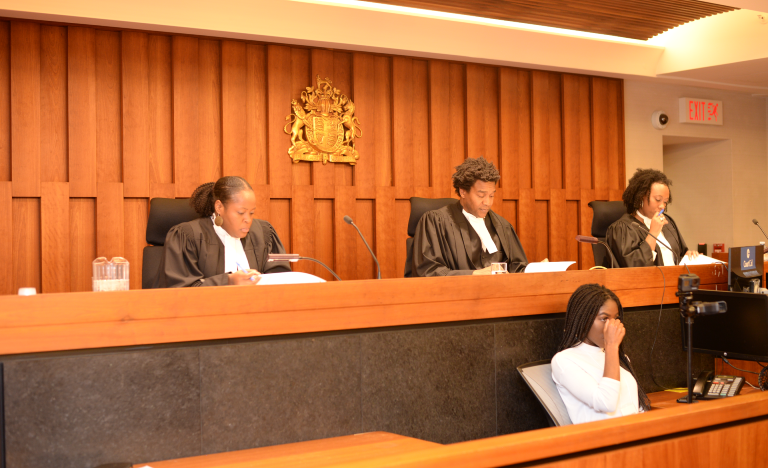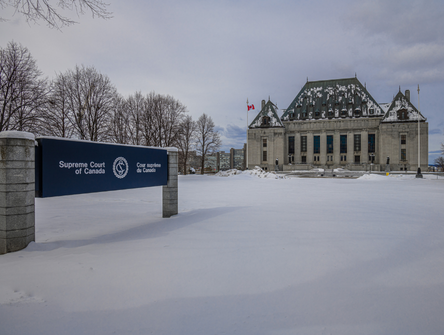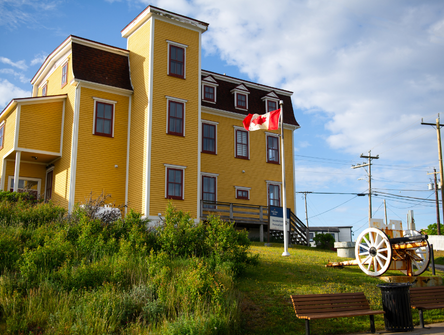Preparing students for racial justice advocacy
How the Julius Alexander Isaac Moot helps up-and-coming lawyers acquire the skills they need to become more effective litigators on matters of equity and inequality.

The for-credit moot, held at the Ontario Court of Appeal this week, is entirely administered by students and focuses on equity and diversity. It is named after the late Federal Court Chief Justice Julius Alexander Isaac, the first black judge to sit on the Federal Court of Canada. Among the judges in attendance at this year's moot are Supreme Court of Canada Justice Mahmud Jamal, Justice Kofi Barnes of the Ontario Superior Court of Justice and Chief Commissioner of the Ontario Human Rights Commission Patricia De Guire.
"The hope for this moot is to identify issues that touch on racial justice that the generation of future lawyers should be thinking about," says Mirabelle Harris-Eze, a law student at the University of Calgary and the national president of the Black Law Students' Association of Canada.
The moot is also a way to educate students on critical race theory, says Chinonso Ekeanyanwu, the national moot director and a law student at Western University.
Critical race theory, or CRT, is an academic field of inquiry that focuses on the intersection of law and racial inequality. "[It's] is not something that is spoken about often in schools," says Ekeanyanwu. But she is hoping that will change.
"CRT is important to learn because law has been used as a tool for institutionalizing white supremacy," says Joshua Sealy-Harrington, an assistant professor of the Lincoln Alexander School of Law. He has volunteered to draft the moot problem for the past four years and served as a moot judge. "Students and young lawyers need to be aware of this to avoid being complicit."
As well as being a lens for students to think more deeply about the law, learning critical race theory is also essential for legal competence, says Sealy-Harrington. "If in a criminal law course, you never talk about race, there is an entire body of jurisprudence that you are not learning — like the impact of race on sentencing and racial profiling — which is a competence issue."
He adds that critical race theory can also develop law students into politically conscious citizens who are aware of inequality. "In the context of Canada, I don't think race is the only thing that matters in understanding power and inequality, but it is one of the things that matters a lot," he says. "Canada is a settler colonial state. It is the product of Indigenous genocide and displacement. It has a long past and present of racial discrimination. For example, if you look at prisons, policing, child welfare, there are massive racial disparities. All of these things in combination tell you that paying attention to race is not a tangent or distraction; it's necessary to understand how legal institutions work."
DeGuire says there are other advantages to exposing students to CRT. For one, it takes into account more than just racial discrimination. "It affords more than a single access framework in which to look at discrimination — be that race, gender, sexuality, religion, etc.," she explains. "Can you imagine dealing with a case where a woman was at work — she's a black woman, she's Muslim, she's disabled, she's LGTB — how do you expect to look at her discrimination in the workplace and say it's just because she wears a hijab?"
CRT also forces people to confront inherent and unconscious biases. "I can't see a tool that is more effective and efficient than a CRT analysis in dealing with human-rights issues and even Charter issues," says Deguire.
In the lead-up to the moot, the Black Law Students' Association of Canada hosted a virtual lecture on critical race theory taught by Professor Michelle Williams of the Schulich School of Law at Dalhousie University in Halifax. The lecture, open to prospective and future moot competitors, law students and the wider community, provided an introductory overview of critical race theory.
The moot has encouraged schools to consider including more diversity-focused courses in their syllabus so students can be prepared, says Harris-Eze. "Students have come back to ask their schools for critical race theory courses and students have felt more comfortable advancing racial justice arguments after graduation," she says.
"This has been a really big advocacy exercise in training the future generation of lawyers."
As well as its emphasis on critical race theory, Ekeanyanwu says that the the moot is also unique in its focus on theory. "We require in our mandate that you involve a theoretical argument in your factum and oral argument," she says.
"Not only do we encourage students to touch on critical race theory, but we also encourage them to touch on other social justice issues like disability law, feminist issues, and other things that sometimes go unspoken in court."
The moot is also an opportunity for students to practice the skills they will need as lawyers, says DeGuire. "To learn the theory, do the research, to see the applicability and understand the importance of it in litigation discourse. It gets them in the habit of honing their listening skills and their analytical skills when dealing with someone with multiple identities," she says.
Since the moot was founded in 2008, Ekeanyanwu says there has been a steady growth in the number of participants and law schools involved. Eleven schools are participating this year.
"Because it's a student-run moot, we really prioritize students and know what they want to see and what they want to learn and how best to achieve that mandate because the perspective is very different," says Ekeanyanwu. "It's a labour of love."


